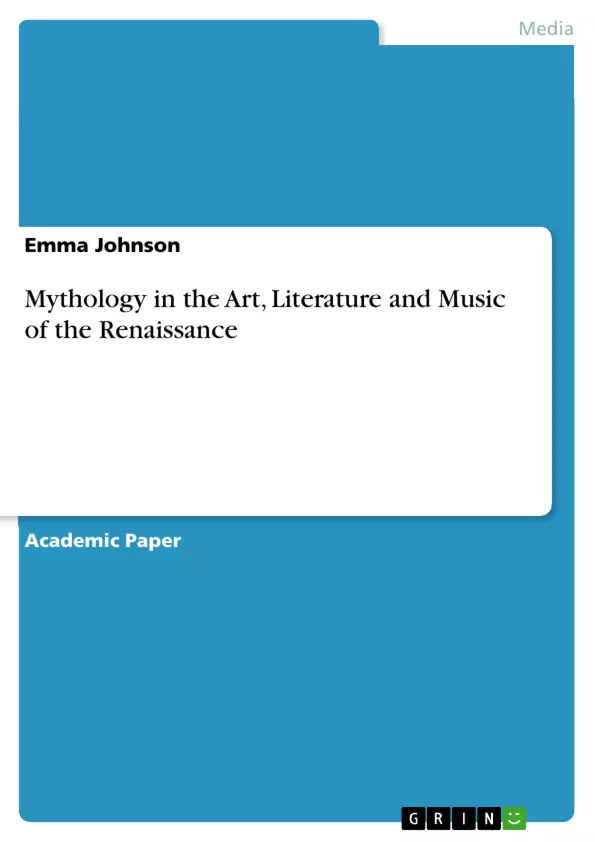This academic essay links mythology to art, literature, and music of the Renaissance. The Renaissance was a time of change amongst those living in the countries that make up Europe. Mythology, during the Renaissance, was visibly expressed through the artwork, music, and literature of those living during this time.
Table of Contents
- Utilizing Fiction
Objectives and Key Themes
This paper explores how Renaissance artists, musicians, and writers utilized classical mythology to convey contemporary social and religious anxieties and aspirations. The paper analyzes the methods through which these narratives were adapted to reflect the changing cultural landscape of the Renaissance.
- The use of mythology in Renaissance art, music, and literature.
- The evolution of mythological figures and their symbolic meaning throughout the Renaissance.
- The relationship between religious beliefs and the portrayal of mythological figures.
- The role of mythology in shaping social and cultural change during the Renaissance.
- The parallels between the use of mythology in the Renaissance and its use in contemporary society.
Chapter Summaries
Utilizing Fiction: This paper examines the pervasive presence of mythology in Renaissance art, music, and literature, arguing that these creative expressions served as powerful tools for conveying social and religious messages. The author explores how the depiction of figures like the Devil in religious art instilled fear and piety, while classical myths like those of Orpheus and Amphion were adapted in music to highlight the power and importance of music itself. Furthermore, the changing portrayal of the werewolf in literature reflects the growing emphasis on individual identity and the evolving religious landscape. The paper concludes by drawing parallels between the use of mythology in the Renaissance and its contemporary relevance, suggesting that humanity consistently uses past narratives to reflect on and address current societal issues. The paper utilizes specific examples from paintings, musical compositions, and literary works to illustrate how mythology was adapted and reinterpreted to suit the changing values and beliefs of the Renaissance period. This analysis showcases how ingrained mythology was in the fabric of Renaissance society and its enduring impact on subsequent eras.
Keywords
Renaissance mythology, art, music, literature, religious symbolism, social change, individual identity, classical myths, devil, Orpheus, Amphion, werewolf.
FAQ: Renaissance Mythology in Art, Music, and Literature
What is the main focus of this academic preview?
This preview provides a comprehensive overview of a paper exploring the use of classical mythology in Renaissance art, music, and literature. It examines how Renaissance artists, musicians, and writers adapted mythological narratives to reflect contemporary social and religious anxieties and aspirations.
What topics are covered in the paper?
The paper investigates several key themes, including the use of mythology in various art forms during the Renaissance; the evolution of mythological figures and their symbolic meaning; the relationship between religious beliefs and mythological portrayals; the role of mythology in shaping social and cultural change; and parallels between the Renaissance use of mythology and its contemporary relevance.
What are the key themes explored in the paper’s chapter summaries?
The preview focuses primarily on the chapter titled "Utilizing Fiction". This chapter analyzes the pervasive presence of mythology in Renaissance art, music, and literature, showing how these art forms served as tools for conveying social and religious messages. Specific examples of mythological figures (e.g., the Devil, Orpheus, Amphion, the werewolf) and their evolving portrayals are discussed, highlighting the reflection of changing societal values and beliefs.
What specific examples are used in the paper?
The paper uses specific examples from paintings, musical compositions, and literary works to illustrate how mythology was adapted and reinterpreted during the Renaissance. The preview mentions the Devil in religious art, Orpheus and Amphion in music, and the werewolf in literature as examples.
What is the overall argument of the paper?
The paper argues that mythology played a crucial role in conveying social and religious messages during the Renaissance. The adaptation and reinterpretation of classical myths reflected the changing cultural landscape and served as a powerful means of addressing contemporary societal issues. The paper also suggests that this use of past narratives to understand the present continues into contemporary society.
What are the key words associated with this paper?
The keywords include Renaissance mythology, art, music, literature, religious symbolism, social change, individual identity, classical myths, devil, Orpheus, Amphion, and werewolf.
What is included in this preview?
This preview includes the title, table of contents, objectives and key themes, chapter summaries, and keywords of the academic paper.
What is the intended audience of this preview?
This preview is intended for academic use, facilitating analysis of the paper's themes in a structured and professional manner.
- Quote paper
- Emma Johnson (Author), 2017, Mythology in the Art, Literature and Music of the Renaissance, Munich, GRIN Verlag, https://www.grin.com/document/423706



